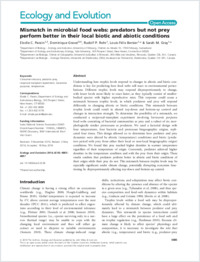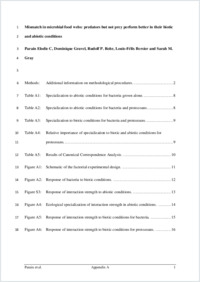Mismatch in microbial food webs: predators but not prey perform better in their local biotic and abiotic conditions
- Parain, Elodie C. Department of Biology – Ecology and Evolution, University of Fribourg, Switzerland - Department of Ecology and Evolutionary Ecology, Yale University, New Haven, Connecticut
- Gravel, Dominique Département de Biologie, Chimie et Géographie, Université duQuébec à Rimouski, Quebec, Canada - Département de Biologie – Ecologie Terrestre, Université de Sherbrooke, Quebec, Canada
- Rohr, Rudolf P. Department of Biology – Ecology and Evolution, University of Fribourg, Switzerland
- Bersier, Louis-Félix Department of Biology – Ecology and Evolution, University of Fribourg, Switzerland
- Gray, Sarah M. Department of Biology – Ecology and Evolution, University of Fribourg, Switzerland
-
21.06.2016
Published in:
- Ecology and Evolution. - 2016, vol. 6, no. 14, p. 4885–4897
English
Understanding how trophic levels respond to changes in abiotic and biotic conditions is key for predicting how food webs will react to environmental perturbations. Different trophic levels may respond disproportionately to change, with lower levels more likely to react faster, as they typically consist of smaller-bodied species with higher reproductive rates. This response could cause a mismatch between trophic levels, in which predators and prey will respond differently to changing abiotic or biotic conditions. This mismatch between trophic levels could result in altered top-down and bottom-up control and changes in interaction strength. To determine the possibility of a mismatch, we conducted a reciprocal-transplant experiment involving Sarracenia purpurea food webs consisting of bacterial communities as prey and a subset of six morphologically similar protozoans as predators. We used a factorial design with four temperatures, four bacteria and protozoan biogeographic origins, replicated four times. This design allowed us to determine how predator and prey dynamics were altered by abiotic (temperature) conditions and biotic (predators paired with prey from either their local or non-local biogeographic origin) conditions. We found that prey reached higher densities in warmer temperature regardless of their temperature of origin. Conversely, predators achieved higher densities in the temperature condition and with the prey from their origin. These results confirm that predators perform better in abiotic and biotic conditions of their origin while their prey do not. This mismatch between trophic levels may be especially significant under climate change, potentially disrupting ecosystem functioning by disproportionately affecting top-down and bottom-up control.
- Faculty
- Faculté des sciences et de médecine
- Department
- Département de Biologie
- Language
-
- English
- Classification
- Biological sciences
- License
-
License undefined
- Identifiers
-
- RERO DOC 277328
- DOI 10.1002/ece3.2236
- Persistent URL
- https://folia.unifr.ch/unifr/documents/305260
Other files
Statistics
Document views: 92
File downloads:
- pdf: 172
- Supplementary material: 129

